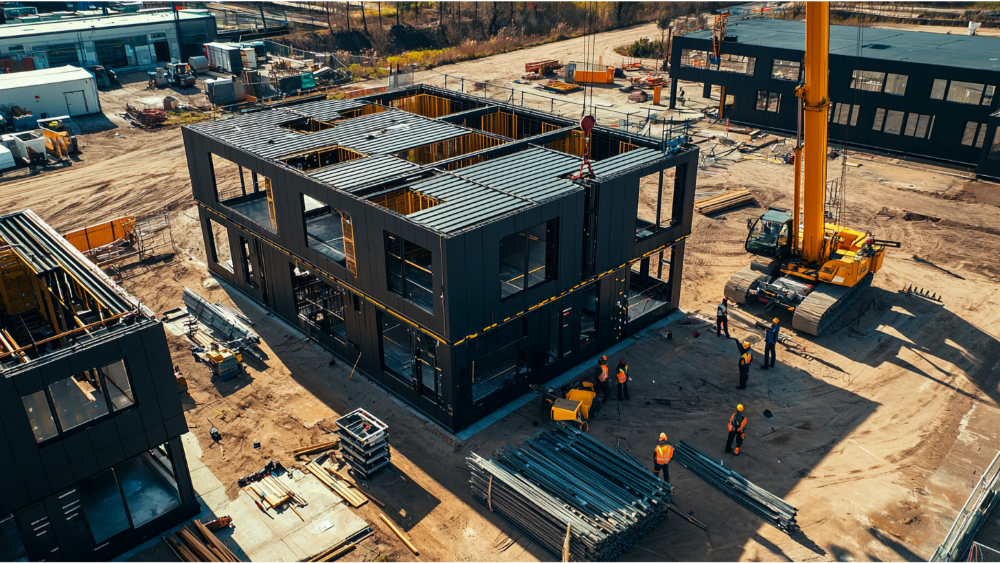Partnered with #1 ADU Builders
Contact Golden State
Drop us a line! We look forward to discussing your next project with you!
Cut the chase! Schedule a face-to-face virtual meeting with us today to dive into your project's next steps.
For our returning clients, experience our streamlined, contact-free project proposal process. Simply fill out our short project questionnaire, and we'll deliver your project proposal within 72 hours.
Contact Us:
Follow Us:

- Golden State Design & Engineering
- Comment 0
Pros And Cons Of Modular Construction
Modular construction is the process of constructing a building from prefabricated, or pre-built, sections that are assembled on-site. This method has been gaining popularity in recent years due to its many benefits over traditional construction methods. However, like any other construction method, there are both pros and cons to using modular construction.
What is Modular Construction?

Modular construction is an innovative building method in which structures are created off-site in factory-controlled environments before being transported to and assembled at the final construction site. These prefabricated components, often referred to as modules, can include entire rooms, complete with walls, flooring, ceilings, and mechanical systems.
Once transported, the modules are secured together to form the final structure, blending seamlessly to appear as traditionally built constructions. This method allows for greater precision, efficiency, and reduced on-site waste.
4 Types of Modular Construction
There are several types of modular construction methods, each with its own unique benefits and applications. Here are some of the most commonly used types:
1 | Volumetric Construction
This method involves creating modules or boxes that can be stacked or fitted together to create a three-dimensional structure. Volumetric construction is often used for residential buildings, such as apartments and student housing.
2 | Panelized Construction
In this type of modular construction, wall panels and other building components are prefabricated in a factory setting and then transported to the site for assembly. Panelized construction is popular for commercial buildings, such as offices and retail spaces.
3 | Hybrid Construction
Hybrid construction combines both volumetric and panelized construction methods. This allows for greater flexibility in design and construction, as well as cost savings.
4 | Offsite vs Onsite Construction
Offsite construction is when the majority of building components are prefabricated in a factory setting and then transported to the site for final assembly. On the other hand, onsite construction involves traditional methods of building where all components are constructed at the site itself. Both approaches have their advantages and disadvantages, but offsite construction is becoming increasingly popular due to its efficiency and speed.
The Origins of Modular Construction

The concept of modular construction dates back to the early 20th century, but its roots can be traced further to the pre-fabrication techniques used during ancient times. The modern modular construction movement began to gain traction during the post-World War II era when the demand for affordable, quickly constructed housing surged.
Prefabrication provided a timely solution, as factories could mass-produce housing components for rapid deployment. Over time, improvements in technology, transportation, and construction materials have transformed modular construction into a sophisticated and sustainable method widely used for residential, commercial, and industrial projects globally.
Modular Building Institute
The Modular Building Institute (MBI) has been instrumental in advancing the modular construction industry, serving as the leading trade association for modular building manufacturers, contractors, and suppliers. Through advocacy, education, and innovation, the MBI has played a critical role in promoting industry standards and fostering collaboration among its members. Their efforts have significantly contributed to the widespread adoption of the modular construction system, helping to highlight its efficiency, sustainability, and flexibility in addressing modern construction challenges.
Modular Construction Advantages
Like any construction method, modular construction also comes with certain advantages that should be taken into account.
Speed
One of the main advantages of modular construction is its speed. Since the modules are built off-site in a factory setting, weather conditions, and delays due to materials or workers are minimized. This results in a shorter overall construction timeline compared to traditional methods.
Cost-effective
Modular construction can also be more cost-effective than traditional methods. With the modules being built in a controlled factory environment, waste and errors can be reduced, resulting in cost savings for the project.
Flexibility
Another benefit of modular construction is its flexibility. Modules can be easily added or removed to accommodate changes in design or future expansion. This makes it an ideal choice for projects that require adaptability.
Quality control
Since the modules are built in a controlled factory setting, they undergo rigorous quality control measures before being transported to the site. This helps ensure a higher level of quality compared to traditional on-site construction methods.
Sustainability
Modular construction also has environmental benefits. The use of pre-fabricated modules reduces both material waste and energy consumption, making it a more sustainable option for construction projects.
Modular Construction Disadvantages

As with any construction method, there are also some potential drawbacks to consider when using modular construction.
Transportation Costs
While the transportation of modules can be more efficient compared to traditional on-site construction materials, it can also come at a higher cost. The size and weight of modules may require specialized transportation methods, adding to the overall project expenses.
Design Limitations
Modular construction requires strict adherence to standard module sizes and shapes, limiting design flexibility. This may not be suitable for projects that require unique or customized designs.
Site Preparation And Foundation Requirements
Although the majority of construction takes place in a factory setting, site preparation and foundation work are still required. This can include excavation, grading, and pouring of concrete foundations, which can add to the overall time and cost of the project.
Weather Restrictions
Due to the factory-based construction process, modular construction may be restricted by weather conditions. Extreme heat, cold, or precipitation can impact the production and transport of modules, leading to delays in project timelines.
Limited Availability Of Skilled Labor
As modular construction is a relatively new method, a limited number of experienced modular construction manufacturers are available for projects. This could result in higher costs for labor or longer lead times for projects.
Building Code Compliance
Modular buildings must adhere to building codes and regulations just like traditional construction methods. However, some building codes may not have specific guidelines for modular construction, leading to potential challenges or delays in obtaining permits.
Golden State Design And Engineering

Why Choose Golden State Design And Engineering?
At Golden State Design and Engineering, we pride ourselves on being leaders in innovation, quality, and exceptional service. With years of expertise in the field, we specialize in designing and engineering cutting-edge modular building solutions tailored to meet the unique needs of our clients.
Our team of skilled professionals is dedicated to delivering projects on time and within budget, ensuring that every detail exceeds expectations. We leverage advanced technology and a comprehensive understanding of building codes to streamline the construction process, minimizing delays and maximizing efficiency.
When you choose Golden State Design and Engineering, you’re not just hiring a company—you’re partnering with a team that’s committed to your success. From concept to completion, we stand by our work and guarantee satisfaction every step of the way.
Frequently Asked Pros And Cons Of Modular Construction Questions
What is Permanent Modular Construction?
Permanent modular construction is one of the innovative modular construction techniques where structures are constructed off-site in controlled factory environments, using the same materials and adhering to the same codes and standards as conventional construction.
The modular components, often referred to as modules, are built to precision and then transported to the final location for assembly. This approach significantly reduces construction timelines while maintaining high quality and durability.
Are Modular Buildings Customizable?
Yes, modular buildings can be fully customized to meet the specific needs and requirements of a project. This includes exterior design options, interior layouts, finishes, and more. Additionally, modular construction allows for scalability, enabling buildings to be expanded or reconfigured as needs evolve. Advanced technology and design tools also offer the ability to create unique architectural features, ensuring that modular buildings not only meet functional needs but also reflect aesthetic preferences.
How Long Does It Take To Construct Modular Structures?
The timeline for constructing a modular building depends on various factors such as the size and complexity of the project. However, in general, modular construction tends to have shorter timelines compared to traditional construction methods. This is because a significant portion of the work is completed off-site in a controlled factory environment while site preparation occurs simultaneously. Factors such as weather conditions, labor availability, and transportation logistics can also influence the overall timeframe, but modular construction typically offers greater efficiency and predictability in delivery.
Can I Add To Or Expand My Modular Building In The Future?
Yes, one of the benefits of the modular construction industry is its flexibility. As your needs change and your business grows, you can easily add onto or expand your modular construction project to accommodate those changes.
Conclusion
In conclusion, modular construction is a cost-effective, efficient, and sustainable solution for various construction projects. Its many benefits make it an attractive option for businesses, schools, healthcare facilities, and even residential housing.
With its fast timelines, high-quality build, and flexibility for future expansion, modular construction is revolutionizing the way we think about traditional construction methods. As technology continues to advance and demand for sustainable building practices increases, modular construction will likely continue to grow in popularity and become a standard in the industry.
Consider incorporating modular construction into your next project to experience its numerous advantages firsthand. So why wait? Start exploring the world of modular construction today!
#NAICS’s:
- 541310 Architectural Services &
- 541330 Engineering Services
DUNS NO:
- 119132267
#SIC’s
- 8712 Architectural Services &
- 8711 Engineering Services
Cage #
- 9R4L5
#UNSPSC’s:
- 81101500, 81101502, 81101505, 81101508, 81101526, 81101533, 81101522

